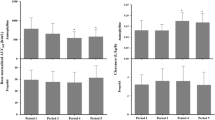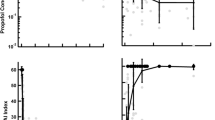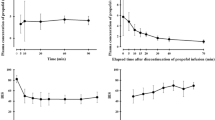Summary
The pharmacokinetics of propofol were studied in nine severely burnt patients undergoing general anaesthesia with enflurane/fentanyl for escarectomy. All patients received an intravenous bolus dose of propofol 2 mg/kg, and blood concentrations of propofol were measured over the subsequent 12 hours using high performance liquid chromatography with fluorescent detection. Propofol blood concentrations, showing a very rapid initial decline and a long terminal elimination phase, were best fitted by a triexponential function describing a 3-compartment open mamillary model with rapid distribution from the central compartment, extensive redistribution and elimination from the central compartment. When compared with nonburnt normal controls, the patients with burns showed lower propofol blood concentrations, lower baseline albumin blood levels (p ≤ 0.001), smaller areas under the concentration-time curve (p ≤ 0.001), larger volumes of distribution (p ≤ 0.001), and higher total body clearance (p ≤ 0.001). Pathophysiological systemic responses to the burn injury and particularly the presence of oedema and changes in albumin concentrations were probably responsible for the significant alterations in the disposition kinetics of propofol in the patients with burns.
Similar content being viewed by others
References
Martyn J. Clinical pharmacology and drug therapy in the burned patient. Anesthesiology 1986; 65: 65–75
Reineke CJ, James MFM, Johnson R. Alfentanil and propofol infusion for surgery in the burned patient. Br J Anaesth 1989; 63: 418–22
Galizia JP, Cantineau D, Selosse A, et al. Essai comparatif du propofol et de la ketamine au cours de l’anaesthésie pour bain des grand brulés. Ann Fr Anesth Réanim 1987; 6: 320–3
Noè L, De Gasperi A, Prosperi M, et al. Propofol anaesthesia for bedside dressings in burned patients. In: Prys Roberts C, editor. Proceedings of Focus on Infusion: Intravenous anaesthesia. London: Current Medical Literature, 1991: 199–201
Galizia JP, Imbenotte M, Hochart D, et al. Etude pharmacocinetique du propofol chez le brulé. Ann Fr Anesth Réanim 1989; 8 Suppl.: R157
Carsin H. Utilisation du Diprivan chez le brulé. Ann Fr Anesth Réanim 1994; 13: 541–4
Bryson HM, Fulton BR, Faulds D. Propofol. An update of its use in anaesthesia and conscious sedation. Drugs 1995; 50: 513–59
Murat I, Billard V, Vernois J, et al. Pharmacokinetics of propofol after a single dose in children aged 1–3 years with minor burns. Anesthesiology 1996; 84: 526–32
Rudy CA, Brater DC. Pharmacokinetics. In: Cernow B, editor. Essentials of critical care pharmacology. 2nd ed. Baltimore: Williams and Wilkins, 1994: 1–17
MacKichan JJ. Protein binding drug displacement interactions: facts or fiction? Clin Pharmacokinet 1989; 16: 65–73
Burch PG, Stanski DR. Decreased protein binding and thiopental kinetics. Clin Pharmacol Ther 1982; 32: 212–7
Shelly MP, Elston AC, Park GR. Sedative and analgesic drugs. In: Park GR, Kang YG, editors. Anaesthesia and intensive care in patients with liver disease. Boston: Butterworth Heinemann, 1995: 57–88
Hull CJ. Intravenous anaesthetic agents. In: Hall CJ, editor. Pharmacokinetics for anaesthesia. Oxford: Butterworth Heinemann, 1991: 253–83
Claeys MA, Gepts E, Camu E. Haemodynamic changes during anaesthesia induced and maintained with propofol. Br J Anaesth 1988; 60: 3–9
Peacock JE, Lewis RP, Reilly CS, et al. Effects of different rates of infusion of propofol for induction of anaesthesia in elderly patients. Br J Anaesth 1990; 65: 346–521
Author information
Authors and Affiliations
Rights and permissions
About this article
Cite this article
De Gasperi, A., Noè, L., Prosperi, M. et al. Pharmacokinetic Profile of the Induction Dose of Propofol in Patients with Severe Burns. Clin. Drug Invest. 14, 314–320 (1997). https://doi.org/10.2165/00044011-199714040-00010
Published:
Issue Date:
DOI: https://doi.org/10.2165/00044011-199714040-00010




